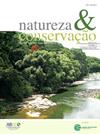关于保护区和其他有效的基于区域的保护措施,以保护生物多样性。探索它们对哥伦比亚蛇的贡献
IF 3.5
2区 环境科学与生态学
Q1 BIODIVERSITY CONSERVATION
引用次数: 0
摘要
其他有效的基于区域的保护措施(oecm)最近在哥伦比亚等国家得到实施,并与保护区(PA)一起成为至关重要的生物多样性保护战略。评估不同区域保护框架(即PA和oecm)的贡献包括评估物种地理范围的代表性程度、代表性目标的实现(即差距分析)、优先保护区域及其与剩余栖息地的关系。蛇调节猎物数量,干扰其他物种的行为和饮食,可以作为生物指标,促进能量和生物量在环境之间的转移,使它们成为保护的重点。目前,哥伦比亚主办>;9科300种蛇。本文探讨了哥伦比亚蛇类的多样性格局及其与剩余生境的关系。我们还评估了物种地理分布、物种丰富度和优先保护区域在PA和oecm中的代表性程度。蛇的丰富度最高的地区是安第斯山脉、太平洋和亚马逊地区;然而,这些主要是在PA和oecm之外。物种范围和代表性目标在PA内的代表性随着oecm的增加而增加。加勒比和安第斯地区的剩余栖息地最少。我们的研究结果强调,oecm对哥伦比亚蛇的保护做出了贡献,并补充了PA。太平洋、奥里诺科河、亚马逊河和北加勒比是最集中的优先保护地区,考虑到土著人民群体的存在和大量剩余的栖息地,这些地区最有希望建立新的东加勒比国家组织。本文章由计算机程序翻译,如有差异,请以英文原文为准。

On protected areas and other effective area-based conservation measures to conserve biodiversity. Exploring their contribution to Colombian snakes
Other effective area-based conservation measures (OECMs) have recently been implemented in countries such as Colombia and, together with protected areas (PA), are crucial biodiversity conservation strategies. Assessing the contribution of different area-based conservation frameworks (i.e., PA and OECMs) involves evaluating the representation degree of species' geographic ranges, representation targets achievement (i.e., Gap analysis), priority areas for conservation, and their relationship with the remaining habitat. Snakes regulate prey populations, interfere with the behavior and diet of other species, can be bioindicators, and facilitate the transfer of energy and biomass between environments, making them a conservation priority. Currently, Colombia hosts > 300 snake species from nine families. Here, we explored the snake diversity pattern in Colombia and its relationship with remaining habitat. We also evaluated the degree of representation within PA and OECMs of species geographic distributions, species richness, and priority areas for conservation. Areas with the highest snake richness are in the Andean, Pacific, and Amazon regions; however, these are predominantly outside PA and OECMs. Representativeness of species ranges and representation targets within PA increased with the OECMs. The Caribbean and Andean regions have areas with the lowest remaining habitat. Our findings highlight that the OECMs contribute to the conservation of snakes in Colombia and complement PA. The Pacific, Orinoco, Amazon, and the northern Caribbean presented the highest concentration of priority areas for conservation and given the presence of indigenous people groups and large remaining habitat, these regions are most promising for creating new OECMs.
求助全文
通过发布文献求助,成功后即可免费获取论文全文。
去求助
来源期刊

Perspectives in Ecology and Conservation
Environmental Science-Nature and Landscape Conservation
CiteScore
7.80
自引率
4.30%
发文量
46
审稿时长
59 days
期刊介绍:
Perspectives in Ecology and Conservation (PECON) is a scientific journal devoted to improving theoretical and conceptual aspects of conservation science. It has the main purpose of communicating new research and advances to different actors of society, including researchers, conservationists, practitioners, and policymakers. Perspectives in Ecology and Conservation publishes original papers on biodiversity conservation and restoration, on the main drivers affecting native ecosystems, and on nature’s benefits to people and human wellbeing. This scope includes studies on biodiversity patterns, the effects of habitat loss, fragmentation, biological invasion and climate change on biodiversity, conservation genetics, spatial conservation planning, ecosystem management, ecosystem services, sustainability and resilience of socio-ecological systems, conservation policy, among others.
 求助内容:
求助内容: 应助结果提醒方式:
应助结果提醒方式:


